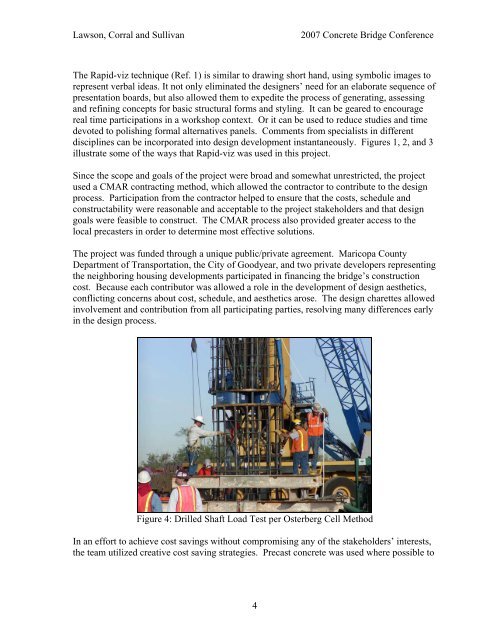ASPIRE Spring 09 - Aspire - The Concrete Bridge Magazine
ASPIRE Spring 09 - Aspire - The Concrete Bridge Magazine
ASPIRE Spring 09 - Aspire - The Concrete Bridge Magazine
Create successful ePaper yourself
Turn your PDF publications into a flip-book with our unique Google optimized e-Paper software.
Lawson, Corral and Sullivan<br />
2007 <strong>Concrete</strong> <strong>Bridge</strong> Conference<br />
<strong>The</strong> Rapid-viz technique (Ref. 1) is similar to drawing short hand, using symbolic images to<br />
represent verbal ideas. It not only eliminated the designers’ need for an elaborate sequence of<br />
presentation boards, but also allowed them to expedite the process of generating, assessing<br />
and refining concepts for basic structural forms and styling. It can be geared to encourage<br />
real time participations in a workshop context. Or it can be used to reduce studies and time<br />
devoted to polishing formal alternatives panels. Comments from specialists in different<br />
disciplines can be incorporated into design development instantaneously. Figures 1, 2, and 3<br />
illustrate some of the ways that Rapid-viz was used in this project.<br />
Since the scope and goals of the project were broad and somewhat unrestricted, the project<br />
used a CMAR contracting method, which allowed the contractor to contribute to the design<br />
process. Participation from the contractor helped to ensure that the costs, schedule and<br />
constructability were reasonable and acceptable to the project stakeholders and that design<br />
goals were feasible to construct. <strong>The</strong> CMAR process also provided greater access to the<br />
local precasters in order to determine most effective solutions.<br />
<strong>The</strong> project was funded through a unique public/private agreement. Maricopa County<br />
Department of Transportation, the City of Goodyear, and two private developers representing<br />
the neighboring housing developments participated in financing the bridge’s construction<br />
cost. Because each contributor was allowed a role in the development of design aesthetics,<br />
conflicting concerns about cost, schedule, and aesthetics arose. <strong>The</strong> design charettes allowed<br />
involvement and contribution from all participating parties, resolving many differences early<br />
in the design process.<br />
Figure 4: Drilled Shaft Load Test per Osterberg Cell Method<br />
In an effort to achieve cost savings without compromising any of the stakeholders’ interests,<br />
the team utilized creative cost saving strategies. Precast concrete was used where possible to<br />
4

















